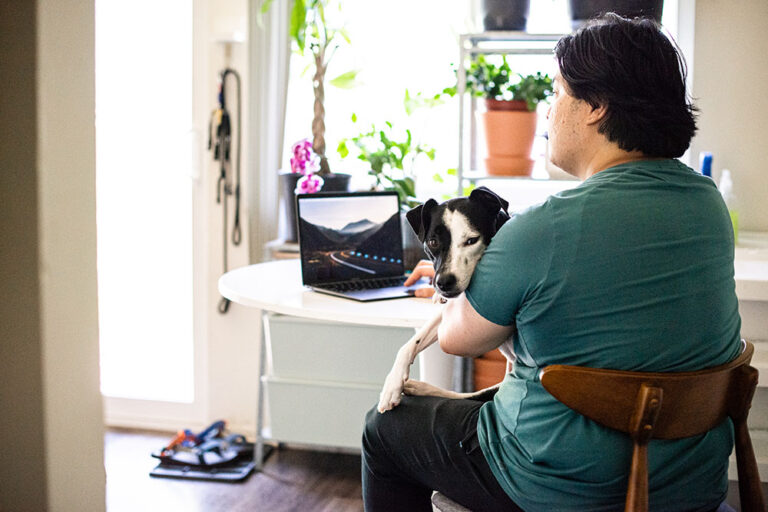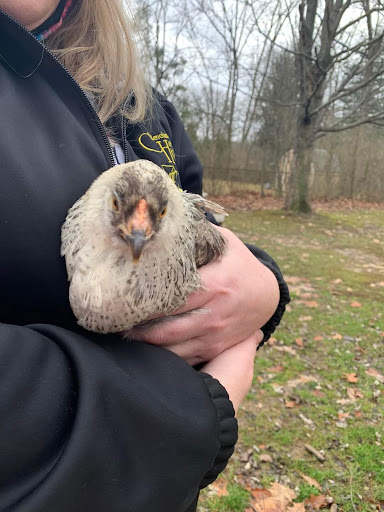
Just before Christmas, Jaime Blados got an email that caught her attention. It asked if anyone could foster some chickens, who had come into Geauga Humane Society’s Rescue Village in Novelty, Ohio.
Jaime is a regular foster for the organization. She mostly takes in dogs. One time she fostered a pig. But chickens?
“I was like, ‘Yeah, we’ll give it a shot,'” Jaime says. “I’m always willing to try.”
Rescue Village’s chicken fostering program is a pretty recent development, one that began because Human & Animal Services Manager Krystyna Zarn-Langford saw the need and thought, why not?
“Chickens are really intelligent, social birds that often seem on par with dogs,” she says. “Even though chickens are often considered meat birds, they should be given the same chances at a humane and peaceful life as those kept purely for companionship.”
Krystyna Zarn-Langford, Human & Animal Services Manager at Rescue Village
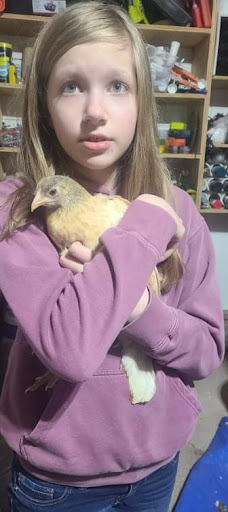
So this past fall, when Rescue Village took in some young hens who’d been rescued out of cruelty, Krystyna decided it was time to launch the chicken fostering program, to help the birds get socialized and stay healthy, plus gather photos and notes that can be used for marketing and successful adoption placement.
Six hens have gone into foster so far. Krystyna says placing chickens into foster homes is not nearly “as scary or inaccessible as it seems!”
“So many supplies that are used for cats, dogs, and rabbits can be repurposed for chickens. Urban and backyard chicken keeping, and urban homesteading, are on the rise so now is the perfect time to not only prepare for those who weren’t ready for chickens, but entice those who are,” she enthuses.
The fosters so far have come from Rescue Village’s pool of existing volunteers. In time, Krystyna plans to expand the program to older hens and roosters. She also expects to open up the program to new chicken fostering families.
Fosters are provided supplies, access to chicken-knowledgeable staff, and care guides and videos. You can check out Rescue Village’s chicken foster guide here.
Fostering out these six chickens so far has not only been a benefit to the hens themselves, but left room in the shelter’s barn just when they needed it.
“We were able to take multiple hens from another rescue who had saved them from a sad situation of neglect but didn’t have appropriate housing,” Krystyna says.
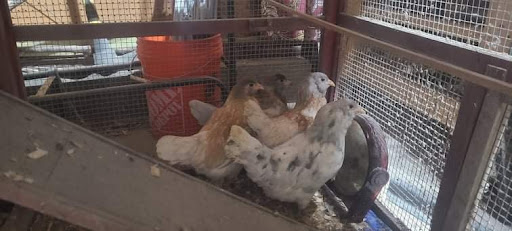
And how’s the eggsperience for the fosters?
“It was fun!” says Jaime, whose foster chickens stayed warm and safe in her two-car garage. “I’ve always wanted to have chickens, but I didn’t really have the time to have my own big coop and all that yet, but it was a cool experience. I would do it again.”
Les Murphy and his family had a very clucking good experience, too. The Murphys—who have one pet chicken of their own already, Pippin, who was adopted from Rescue Village, in addition to two human children, four dogs, six cats, a leopard gecko, and a toad—took in four foster chickens, also for a few weeks through Christmas. (You can just skip the obvious dark jokes about bringing home chickens for Christmas. Les and his family are vegetarians.)
As for the foster chickens, “they were great,” Les says. “They were a little skittish around people, but they would let us pick them up and hold them and they were fine with that. One of them actually looked like a little snowy owl. We called her Hedwig, of course. She would actually ride around on my daughter’s shoulder and just kind of hang out like a parrot for a bit, and then she’d be like, oh, I’m done and wander off.”
The other fosters were named Crookshanks, Hermione, and Ginny. Sensing a theme, Harry Potter fans?
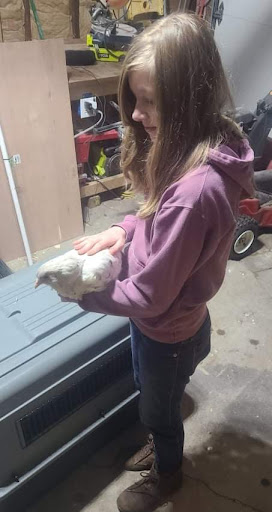
Their family’s chicken helped out, too, by teaching the fosters how to “chicken.”
“There was definitely a lot of them watching her, seeing what she was doing and figuring out, oh, these are the good treats that they hid in here. OK, go for the blueberries. Got it,” Les says.
Krystyna says it’s never too hard to find homes for young hens, but “having the photos and knowledge of these ladies beforehand went a long way towards marketing them. Also having them in a foster home and opening up space at the shelter for other chickens was a huge benefit.”
And because of all this, it won’t come as much of a surprise that she recommends other shelters and organizations try fostering out chickens, too.
“It’s not as scary or inaccessible as it seems!” she says, laying out a few tips:
- Chicken fosters don’t need special chicken coops but they do need a safe place for the birds to escape the elements (and predators), like a garage, dog house, or outdoor shed.
- If no one on your staff has experience with chickens, “reach out to more rural rescues who oftentimes have experienced chicken keepers that would love to help with advice and training.”
- Engage your current foster pool. “So many foster volunteers are thrilled at the idea of a new challenge, and will provide the photos, videos, stories, and word of mouth you need to get the program off the ground.”
- Your chicken foster program, like any specialized program, will need some development, marketing, and training.
Krystyna waxes rhapsodic about the benefits of fostering for chickens and for humans. They’ll thrive in a safe, loving home, where they can get healthy and learn to trust humans. They’ll eat bugs in your lawn and enrich the soil, while they do it. Plus “there is nothing more zen than reading or gardening with the girls as they snuggle in your lap and make happy chicken noises.”
As you may have guessed, Krystyna is not just a promoter of chicken fostering. She’s a chicken foster herself.
A foster hen named Harriet stays with her, inspiring this push to give others the same chance at a happy home.
Harriet came into rescue, out of extreme neglect. “She was emaciated, riddled with parasites, had been plucked half-naked by the other chickens, and had a leg that had been badly broken but never treated,” Krystyna says. Harriet had to hop around on her one good leg, and needed ramps to get in and out of her enclosure.
Krystyna was determined to give Harriet the medicine, comfort, and safety she needed to get healthy. And within three weeks of coming into foster, the shy, sick bird had grown beautiful feathers, and had gained weight and self-assurance.
“She went from a scared hen hiding in the back of her house to a confident bird who loved looking out the window, basking in the sunlight making happy noises,” Krystyna says. “Having a safe, clean space with a known routine and familiar, kind handlers is so important to a happy and healthy bird.”


